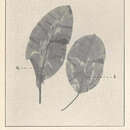Comments
provided by eFloras
No specimens have been seen from Kentucky or Texas, but the species is to be expected there.
Potamogeton amplifolius is common throughout much of North America. Its submersed leaves are larger than those of most other species of Potamogeton, are arcuate, and have more veins than do any other species.
One hybrid, Potamogeton amplifolius ´ P. illinoensis (= P. ´ scoliophyllus Hagström), has been described.
- license
- cc-by-nc-sa-3.0
- copyright
- Missouri Botanical Garden, 4344 Shaw Boulevard, St. Louis, MO, 63110 USA
Description
provided by eFloras
Rhizomes present. Cauline stems terete, often rusty spotted, 6--110 cm; nodal glands absent. Turions absent. Leaves both submersed and floating or floating absent, ± spirally arranged. Submersed leaves petiolate, lax; stipules persistent, conspicuous, convolute, free from blade, light brown, not ligulate, 1.5--11.7 cm, not fibrous, not shredding at tip, apex acute; petioles terete, 0.9--11.5 cm; blade light to dark green, ovate to oblanceolate, distinctly arcuate, 5--12.5 cm ´ 15--58 mm, base rounded to acute, without basal lobes, not clasping, margins entire, crispate, apex not hoodlike, acute to round-apiculate, lacunae absent; veins 19--49. Floating leaves: petioles continuous in color to apex, 2.3--22.6 cm; blade adaxially light green, lanceolate to round elliptic, 4.3--9.2 cm ´ 25--38 mcm, base rounded to cordate, apex acute to rounded; veins 27--49. Inflorescences unbranched, emersed; peduncles not dimorphic, terminal or axillary, erect, cylindric, 4.5--22.3 cm; spikes not dimorphic, cylindric, 34--65 mm. Fruits sessile, reddish brown, obovoid, turgid, abaxially keeled, laterally ridged, 5--6.7 ´ 4.5--5.2 mm, lateral ridges without points; beak erect, 0.5--0.8 mm; sides without basal tubercles; embryo with full spiral. 2n = 52.
- license
- cc-by-nc-sa-3.0
- copyright
- Missouri Botanical Garden, 4344 Shaw Boulevard, St. Louis, MO, 63110 USA
Distribution
provided by eFloras
B.C., Man., N.B., Nfld. and Labr. (Nfld.), N.S., Ont., Que., Sask.; Ala., Ark., Calif., Conn., Ga., Idaho, Ill., Ind., Iowa, Kans., Maine, Md., Mass., Mich., Minn., Mo., Mont., Nebr., N.H., N.J., N.Y., N.C., Ohio, Okla., Oreg., Pa., R.I., S.Dak., Tenn., Vt., Va., Wash., W.Va., Wis., Wyo.
- license
- cc-by-nc-sa-3.0
- copyright
- Missouri Botanical Garden, 4344 Shaw Boulevard, St. Louis, MO, 63110 USA
Flowering/Fruiting
provided by eFloras
Flowering summer--fall.
- license
- cc-by-nc-sa-3.0
- copyright
- Missouri Botanical Garden, 4344 Shaw Boulevard, St. Louis, MO, 63110 USA
Habitat
provided by eFloras
Waters of lakes, ponds, streams, and rivers; 0--1900(--2900)m.
- license
- cc-by-nc-sa-3.0
- copyright
- Missouri Botanical Garden, 4344 Shaw Boulevard, St. Louis, MO, 63110 USA
Comprehensive Description
provided by North American Flora
Potamogeton amplifolius Tucker m. Am. Jour. Sci
II. 6 : 225. 1848.
IP. amplifolius ovalifolius Morong; A. Benn. Jour. Bot. 42 : 70. 1904.
Stem simple or sparingly branched ; floating leaves petioled ; blades coriaceous, 32-40nerved, ovate or elliptic-ovate, acute or acuminate at the apex, rounded or subcordate at the base, 6-10.5 cm. long, 2,7-5.1 cm. wide, in rare forms longer and wider; petioles 8-13 cm. long; stipules acute, 2-keeled, sometimes 10 cm. long, usually shorter ; submerged leaves of two kinds, the upper elliptic or ovate, the lower lanceolate or sometimes falcate, 6-10.5 cm, long, 2.7-5.1 cm. wide ; petioles 1-3.5 cm. long, usually winged ; spikes cylindric, 2.5^4.9 cm. long, densely-flowered ; peduncles 5-18 cm. long, twice as thick as the petioles of the floating leaves ; nutlets smooth, 3-keeled, the middle keel larger than the lateral ones ; embryo a complete spiral, the curved apex pointing inside the base.
Type locality : Cambridge, Massachusetts.
Distribution : New Brunswick to British Columbia, south to Georgia and Nebraska ; reported also from Florida and Alabama.
- bibliographic citation
- Percy Wilson, Per Axel Rydberg, Norman Taylor, Nathaniel Lord Britton, John Kunkel Small, George Valentine Nash. 1909. PANDANALES-POALES; TYPHACEAE, SPARGANACEAE, ELODEACEAE, HYDROCHARITACEAE, ZANNICHELLIACEAE, ZOSTERACEAE, CYMODOCEACEAE, NAIADACEAE, LILAEACEAE, SCHEUCHZERIACEAE, ALISMACEAE, BUTOMACEAE, POACEAE (pars). North American flora. vol 17(1). New York Botanical Garden, New York, NY
Potamogeton amplifolius
provided by wikipedia EN
Potamogeton amplifolius, commonly known as largeleaf pondweed or broad-leaved pondweed, is an aquatic plant of North America. It grows in water bodies such as lakes, ponds, and rivers, often in deep water.
This perennial plant grows from rhizomes and produces a very slender, cylindrical, sometimes spotted stem up to a meter or so long. The leaves take two forms. Submersed leaves are up to 20 centimeters long by 7 wide and may be folded along their midribs. The submersed leaves have more veins than do those of other pondweed species, up to 49.[1] Floating leaves are up to 10 centimeters long by 5 wide, leathery in texture, and borne on long petioles. The inflorescence is a spike of many flowers rising above the water surface on a thick peduncle.
References

- license
- cc-by-sa-3.0
- copyright
- Wikipedia authors and editors
Potamogeton amplifolius: Brief Summary
provided by wikipedia EN
Potamogeton amplifolius, commonly known as largeleaf pondweed or broad-leaved pondweed, is an aquatic plant of North America. It grows in water bodies such as lakes, ponds, and rivers, often in deep water.
This perennial plant grows from rhizomes and produces a very slender, cylindrical, sometimes spotted stem up to a meter or so long. The leaves take two forms. Submersed leaves are up to 20 centimeters long by 7 wide and may be folded along their midribs. The submersed leaves have more veins than do those of other pondweed species, up to 49. Floating leaves are up to 10 centimeters long by 5 wide, leathery in texture, and borne on long petioles. The inflorescence is a spike of many flowers rising above the water surface on a thick peduncle.
- license
- cc-by-sa-3.0
- copyright
- Wikipedia authors and editors

